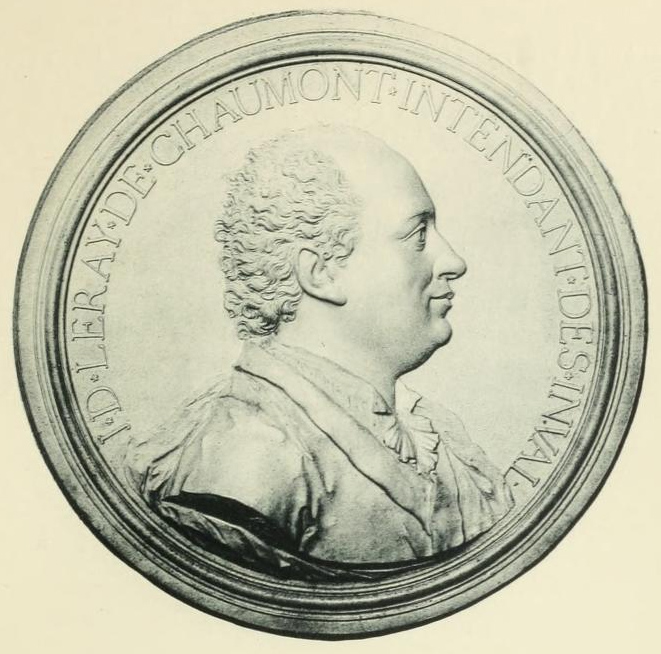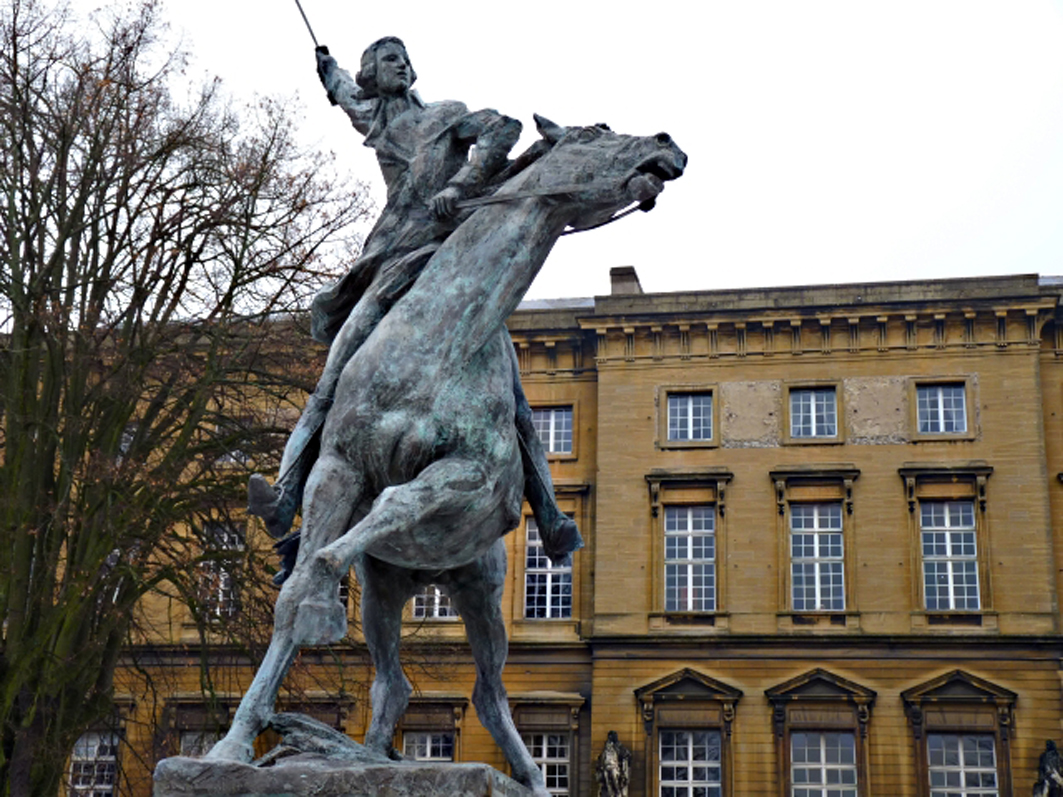|
Jacques-Donatien Le Ray De Chaumont
Jacques-Donatien Le Ray de Chaumont (1 September 1726 – 22 February 1803) was a French "Father of the American Revolution", but later an opponent of the French Revolution. His son of the same name, known also in America as James Le Ray, eventually became a United States citizen and settled in Le Ray, New York, United States. American Revolution Le Ray de Chaumont served King Louis XVI at the Court at Versailles as the Governor of Les Invalides in Paris and the Grand Master of Waters and Lands of Blois. Following the Declaration of Independence from Great Britain, by the American colonies on 4 July 1776, emissaries were dispatched to France by the new United States revolutionary government to seek assistance from the French king. Although anxious to see Great Britain weakened, Louis XVI had to walk a political tightrope. He understood that support for the rebellion in America was a contradiction of France's global colonization policies and could spark a revolt in any n ... [...More Info...] [...Related Items...] OR: [Wikipedia] [Google] [Baidu] |
Leray De Chaumont By Nini
Leray or LeRay is a surname. Notable people with the surname include: * David Leray (born 1984), French footballer * Francis Xavier Leray (1825–1887), American prelate of the Roman Catholic Church * Jean Leray (1906–1998), French mathematician * Marie-Pierre Leray (born 1975), French figure skater * Coi Leray, stage name of American rapper and singer Coi Leray Collins (born 1997) See also * LeRay Mansion, Fort Drum, New York, United States, on the National Register of Historic Places See also * Le Ray (other) {{surname ... [...More Info...] [...Related Items...] OR: [Wikipedia] [Google] [Baidu] |
Chaumont-sur-Loire
Chaumont-sur-Loire (, ), commonly known as Chaumont, is a commune and town in the Loir-et-Cher department and the administrative region of Centre-Val de Loire, France, known for its historical defensive walls and its castle. Château de Chaumont-sur-Loire The castle was founded by Odo 1 (973-996), Count of Blois. Throughout the castle's existence, it has been owned by numerous significant historical figures in French and European history. In the period between the late enlightenment and the romantic period, Germaine de Staël was resident from April to August 1810. Many famous guests visited the lively and politically active Madame de Staël including Madame Récamier, Adelbert von Chamisso, the counts of Sabran and Salaberry as well as the author of "Adolphe", Benjamin Constant.Chateau de Chamont-Sur-Loire, Arts and Nature centre. http://www.domaine-chaumont.fr/en Gallery Chaumont Garden Festival File:France Loir-et-Cher Chaumont-sur-Loire Jardin 01.jpg File:France Loir-et- ... [...More Info...] [...Related Items...] OR: [Wikipedia] [Google] [Baidu] |
Chaumont, New York
Chaumont ( ) is a village in Jefferson County, New York, United States. Its population was 624 at the 2010 census. The village is named for Jacques-Donatien Le Ray de Chaumont, son of Benjamin Franklin's landlord and friend at Passy in France. The village of Chaumont is in the town of Lyme and is northwest of Watertown. History In 1750, Ray had bought the Chaumont castle (named from the Old French for "bald hill", and built in two periods around 1500) in the Loire Valley of France. (, the village near it is called Chaumont-sur-Loire to distinguish it from the many other Chaumont (other), Chaumonts in France.) His son, known as James Leray or James Leray Chaumont, travelled to the United States and later settled there. The first European-descended settlement of the village began in 1802, replacing an unsatisfactory site chosen the previous year. References External links Chaumontny.org Lyme Parks and Recreation Lyme Community FoundationChaumont–Three Mile Ba ... [...More Info...] [...Related Items...] OR: [Wikipedia] [Google] [Baidu] |
Smithsonian Institution
The Smithsonian Institution ( ), or simply the Smithsonian, is a group of museums, Education center, education and Research institute, research centers, created by the Federal government of the United States, U.S. government "for the increase and diffusion of knowledge". Founded on August 10, 1846, it operates as a trust instrumentality and is not formally a part of any of the Federal government of the United States#branches, three branches of the federal government. The institution is named after its founding donor, British scientist James Smithson. It was originally organized as the United States National Museum, but that name ceased to exist administratively in 1967. The Smithsonian Institution has historical holdings of over 157 million items, 21 museums, 21 libraries, 14 education and research centers, a zoo, and historical and architectural landmarks, mostly located in Washington, D.C. Additional facilities are located in Maryland, New York (state), New York, and Virg ... [...More Info...] [...Related Items...] OR: [Wikipedia] [Google] [Baidu] |
Joseph Siffred Duplessis
Joseph-Siffred Duplessis (22 September 1725 – 1 April 1802) was a French painter known for the clarity and immediacy of his portraits. Early life He was born in Carpentras, near Avignon, into a family with an artistic bent and received his first training from his father, a surgeon and talented amateur. He subsequently studied with Joseph Gabriel Imbert (1666–1749), who had been a pupil of Charles Le Brun. From 1744 to 1747 or later he worked in Rome, in the atelier of Pierre Subleyras (1699–1749), who was also from the south of France. In Italy Duplessis became fast friends with Joseph Vernet, another Provençal speaking Occitania. Career Duplessis returned to Carpentras, spent a brief time in Lyon then arrived about 1752 in Paris, where he was accepted into the Académie de Saint-Luc and exhibited some portraits, which were now his specialty, in 1764, but did not achieve much notice until his exhibition of ten paintings at the Paris salon of 1769, very well received a ... [...More Info...] [...Related Items...] OR: [Wikipedia] [Google] [Baidu] |
Treaty Of Paris (1783)
The Treaty of Paris, signed in Paris by representatives of King George III of Kingdom of Great Britain, Great Britain and representatives of the United States on September 3, 1783, officially ended the American Revolutionary War and recognized the Thirteen Colonies, which had been part of colonial British America, to be free, sovereign and independent states. The treaty set the Demarcation line, boundaries between British North America, later called Canada, and the United States, on lines the British labeled as "exceedingly generous", although exact boundary definitions in the far-northwest and to the south continued to be subject to some controversy. Details included fishing rights and restoration of property and Prisoners of war in the American Revolutionary War, prisoners of war. This treaty and the separate peace treaties between Great Britain and the nations that supported the American cause, including Kingdom of France, France, History of Spain (1700–1808), Spain, and ... [...More Info...] [...Related Items...] OR: [Wikipedia] [Google] [Baidu] |
John Paul Jones
John Paul Jones (born John Paul; July 6, 1747 – July 18, 1792) was a Scottish-born naval officer who served in the Continental Navy during the American Revolutionary War. Often referred to as the "Father of the American Navy", Jones is regarded by several commentators as one of the greatest naval commanders in the military history of the United States. Born in Arbigland, Kirkcudbrightshire, Jones became a sailor at the age of thirteen, and served onboard several different merchantmen, including slave ships. After killing a mutinous subordinate, he fled to the British colony of Virginia to avoid being arrested and in joined the newly established Continental Navy. During the ensuing war with Kingdom of Great Britain, Great Britain, Jones participated in several Naval battles of the American Revolutionary War, naval engagements with the Royal Navy. Commanding the warship ''USS Ranger (1777), Ranger'', Jones conducted a naval campaign in the North Sea, attacking British merchant ... [...More Info...] [...Related Items...] OR: [Wikipedia] [Google] [Baidu] |
Charles-Hector Estaing
Jean Baptiste Charles Henri Hector, Count of Estaing (24 November 1729 – 28 April 1794) was a French military officer and writer. He began his service as a soldier in the War of the Austrian Succession, briefly spending time as a prisoner of war of the British during the Seven Years' War. Naval exploits during the latter war prompted him to change branches of service, and he transferred to the French Navy. Following France's entry into the American War of Independence in 1778, d'Estaing led a fleet to aid the American rebels. He participated in a failed Franco-American siege of Newport, Rhode Island, in 1778, and the equally unsuccessful 1779 Siege of Savannah. He did have success in the Caribbean before returning to France in 1780. His difficulties working with American counterparts are cited among the reasons these operations in North America failed. Although d'Estaing sympathized with revolutionaries during the French Revolution, he held a personal loyalty to the French ... [...More Info...] [...Related Items...] OR: [Wikipedia] [Google] [Baidu] |
American Revolution
The American Revolution (1765–1783) was a colonial rebellion and war of independence in which the Thirteen Colonies broke from British America, British rule to form the United States of America. The revolution culminated in the American Revolutionary War, which was launched on April 19, 1775, in the Battles of Lexington and Concord. Leaders of the American Revolution were Founding Fathers of the United States, colonial separatist leaders who, as British subjects, initially Olive Branch Petition, sought incremental levels of autonomy but came to embrace the cause of full independence and the necessity of prevailing in the Revolutionary War to obtain it. The Second Continental Congress, which represented the colonies and convened in present-day Independence Hall in Philadelphia, formed the Continental Army and appointed George Washington as its commander-in-chief in June 1775, and unanimously adopted the United States Declaration of Independence, Declaration of Independence ... [...More Info...] [...Related Items...] OR: [Wikipedia] [Google] [Baidu] |
Comte De Vergennes
Charles Gravier, comte de Vergennes (; 29 December 1719 – 13 February 1787) was a French statesman and diplomat. He served as Foreign Minister from 1774 to 1787 during the reign of Louis XVI of France, Louis XVI, notably during the American War of Independence. Vergennes rose through the ranks of the diplomatic service during postings in Portugal and Germany before receiving the important post of Envoy to the Ottoman Empire in 1755. While there he oversaw complex negotiations that resulted from the Diplomatic Revolution before being recalled in 1768. After assisting a pro-French faction to take power in Sweden, he returned home and was promoted to foreign minister. Vergennes hoped that by giving French aid to the American revolutionaries he would be able to weaken British dominance of the international stage, in the wake of Britain's over France in the recent Seven Years' War. Alliance with the revolutionaries produced mixed results for France as, despite helping to defeat Bri ... [...More Info...] [...Related Items...] OR: [Wikipedia] [Google] [Baidu] |
Marquis De Lafayette
Marie-Joseph Paul Yves Roch Gilbert du Motier de La Fayette, Marquis de La Fayette (; 6 September 1757 – 20 May 1834), known in the United States as Lafayette (), was a French military officer and politician who volunteered to join the Continental Army, led by General George Washington, in the American Revolutionary War. Lafayette was ultimately permitted to command Continental Army troops in the decisive Siege of Yorktown in 1781, the Revolutionary War's final major battle, which secured American independence. After returning to France, Lafayette became a key figure in the French Revolution of 1789 and the July Revolution of 1830 and continues to be celebrated as a hero in both France and the United States. Lafayette was born into a wealthy land-owning family in Chavaniac in the province of Auvergne in south-central France. He followed the family's martial tradition and was commissioned an officer at age 13. He became convinced that the American revolutionary cause was ... [...More Info...] [...Related Items...] OR: [Wikipedia] [Google] [Baidu] |




